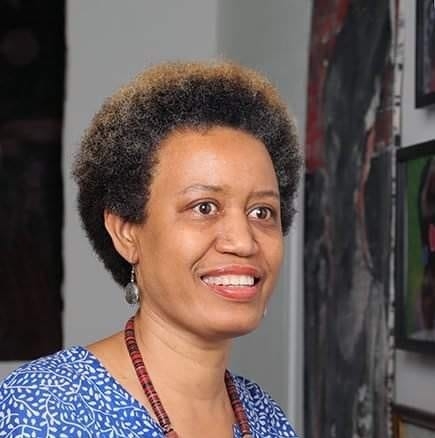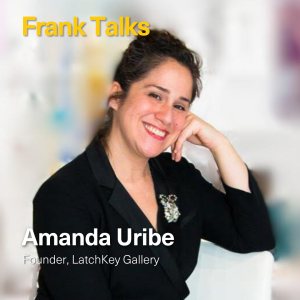Atim Annette Oton is a Nigerian-born, American and British educated designer turned Curator. She is the director and curator of Calabar Gallery in New York. She is the African Art Curator for AMREF Health Africa ARTBALL, an advisor to The David Prize and The Downtown Biennial. A daughter of an art collector and journalist, she spent her formative years in Calabar, Nigeria and studied architecture at the City College of New York and did graduate studies at the Architectural Association Graduate School in London, England. In New York, she worked in architecture and by 2000, was part of the design team that won the African Burial Ground Interpretive Center and became the Associate Chair of Product Design at Parsons School of Design before leaving to create her retail company in 2006 and opening Calabar in 2016. Her gallery, Calabar represents underserved artists locally and globally: African, African American and Caribbean artists, with the mission of providing a place for community, exhibition, creative initiatives and projects. She is the organizer for Harlem Arts Stroll.
What was your first job in the Arts and what was the most useful or important thing you learned in that experience?
I began curating in 2006 in my own space but my first consulting job was with Bronx Council’s Longwood Gallery as curator for public programming for the exhibition Bronx:Africa. I learnt how to reach an audience that was ignored and utilized social media to reach them. I led the innovative public programming and community events for the exhibition that were African-centered and got the full support of the Executive Director to do so.
Tell us a little more about yourself. When did you realize you wanted to pursue a career in this industry?
I am a Nigerian born woman whose father first came to the US in the 1950’s to go to school and returned in 1962 to Nigeria with my American mother whose Caribbean heritage is from Trinidad and Jamaica. I spent most of my summers in the US as a child and came to live in the 1980’s to also go to school and unlike my parents stayed on to work professionally and grow a career in architecture, and now an art business.
I joined the exhibition committee at Parsons School of Design when I became the associate chair in 2000 and as we decided on exhibitions to show – it became clear that I loved the process of selecting and curating and after leaving Parsons in 2006, I began curating off-and-on but started in my own retail space.
What do you do now?
I am an art curator, gallery owner and director of Calabar Gallery based in Harlem, New York.
Where are you from and what is the arts community like there?
I was born in Nigeria with a Nigerian father and an American mother whose parents were Caribbean – Trinidadian and Jamaican. My mother began collecting Nigerian art as early as 1963 and supported a lot of artists in Calabar where I was born and grew up. The arts community is diverse, rich in artists, varied in practices and one of the largest in Africa.
Has where you come from shaped what you do in the arts today?
Yes, I began in architecture not fine art and the processes to conceive and building a building are similar to an exhibition. As a curator – I chose the right part of the arts to be in – one that is about developing artists, building exhibitions and collections.
What is the best piece of advice you can give about working in the art world?
Do what you love with passion, intensity and zest. Laugh a lot and have fun.
What is one of the greatest accomplishments in your career so far? And what has been a challenge?
Growing Calabar Gallery to be a unique experience: representing artists in 5 locations globally, exhibiting their work in the gallery, at art fairs and working with them to get into residencies.
How is your current job adapting to the ever-changing digital landscape? What do you think can be done better, if anything?
As a curator, the ability to pivot is key and the tenacity to take risks is vital. In the midst of the pandemic – I was building audience by getting up and running online, virtually doing art fairs, art auctions and talks. It was an environment to experiment and explore new ways of working. Accepting that things change goes a long way.
What is one of the weirdest things you have had to do on the job?
Art World? Weird? Weird is normal.
What do you think defines a good employee? And what defines a good boss?
Listening, curiosity and initiative.
What is your advice for making yourself stand out in the workplace? Any good tips for giving a great interview?
Be different, take risks and be honest about your skills. Say you don’t know and are willing to learn. And stay off the cell phone at work.
What artwork is/was in your home office?
It is currently filled with Nigerian artists from 1960 to 2021 but I rotate it seasonally and I try to keep my collection private.
What is/was your greatest WFH challenge? Or a WFH luxury you don’t want to lose ever again?
Pivoting was the greatest challenge and Collaboration is the WFH luxury I plan not to lose.
What about the art world in 2022 are you most excited about?
The possibilities. We are now in a hybrid world of virtual and onsite in a way that your ability to imagine, conceive and implement is key in. Exploring new ways and places for artists. Collaborating in new ways.
Is there any advice you would like to give people entering the art world?
Jump in with all of your might. Explore, take risks and stop waiting to do something!
What is the best exhibition you have seen recently?
One I saw digitally as I was not able to travel to Holland – Slavery in Rijksmuseum but in person Grief and Grievance at the New Museum. So much to ponder about both of them
How do you think the art world can become more transparent?
I start with myself and the artists I work with. In my corner of the art world, change happens with me.
How do you think art should be shared and/or experienced moving forward?
Whatever we imagine can be achieved if we put our minds to it.
If you could own a work by 5 different artists, who would be in your collection?
Too many – but these days I am focused on African American artists who are doing large size pieces that can’t fit my apartment: Faith Ringold, Mark Bradford, Terry Adkins, Nari Ward, Howardena Pindell, Nick Cave, Sam Gilliam, David Hammons…I could go on and on and always Senga Nengudi. And always El Anatsui as the African artist to collect.




